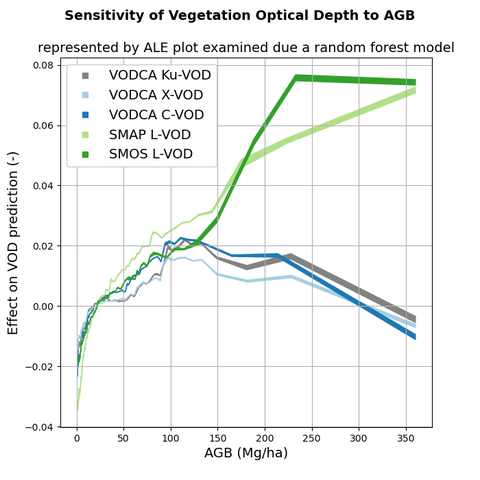Mar 23, 2023
Assessing the sensitivity of multi-frequency passive microwave vegetation optical depth to vegetation properties
Vegetation attenuates the microwave emission from the land surface. The strength of this attenuation is quantified in models in terms of the parameter Vegetation Optical Depth (VOD), and is influenced by the vegetation mass, structure, water content, and observation wavelength. Earth observation satellites operating in the microwave frequencies are used for global VOD retrievals, enabling the monitoring of vegetation status at large scales. VOD has been used to determine above-ground biomass, monitor phenology or estimate vegetation water status. VOD can be also used for constraining land surface models or modelling wildfires at large scale. Several VOD products exist differing by frequency/wavelength, sensor, and retrieval algorithm. Numerous studies present correlations or empirical functions between different VOD datasets and vegetation variables such as normalised difference vegetation index, leaf area index, gross primary production, biomass, vegetation height or vegetation water content. However, an assessment of the joint impact of land cover, vegetation biomass, leaf area, and moisture status on the VOD signal is challenging and has not yet been done. This study aims to interpret the VOD signal as a multi-variate function of several descriptive vegetation variables. The results will help to select certain VOD wavelengths for specific applications and can guide the development of appropriate observation operators to integrate VOD with large-scale land surface models. Here we use VOD from the Land Parameter Retrieval Model (LPRM) of Ku-, X- and C-bands of the harmonised VODCA dataset and level 3 L-band derived from SMOS and SMAP sensors. Within a multivariable regression random forest model for simulating these VOD signals, leaf area index, live-fuel moisture content, above-ground biomass, and land cover are able to explain up to 0.95 of the variance (coefficient of determination). Thereby, the variance in L-band VOD is reproduced spatially and for Ku-, X- and C-band VOD spatially as well as temporally. Analyses of accumulated local effects demonstrate that Ku-, X- and C-band VOD is mostly sensitive to leaf area index and L-band VOD to above-ground biomass. However, for all VODs the global relationships with vegetation properties are non-monotonic and complex and differ with land cover type. This indicates that the use of simple global regressions to estimate single vegetation properties (e.g. above-ground biomass) from VOD is over-simplistic.
Publication:
Schmidt, L., Forkel, M., Zotta, R.-M., Scherrer, S., Dorigo, W. A., Kuhn-Régnier, A., van der Schalie, R., and Yebra, M. (2022).
Assessing the sensitivity of multi-frequency passive microwave vegetation optical depth to vegetation properties
Biogeosciences 20, 1027–1046, https://doi.org/10.5194/bg-20-1027-2023

